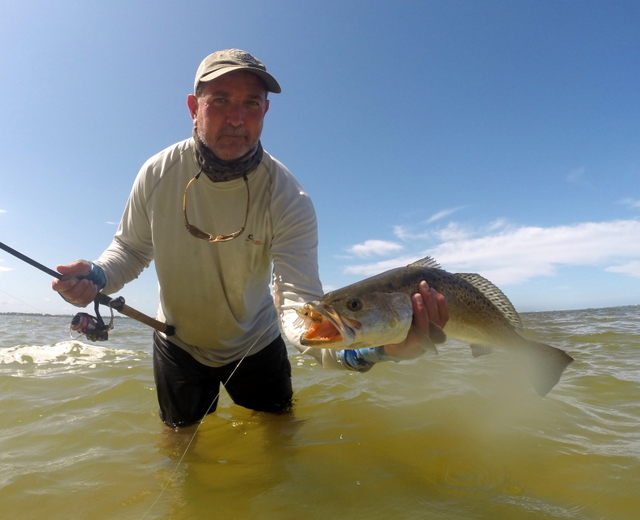
Paul Macinnis with a healthy No Motor Zone trout!
Nestled in the northern reaches of the Banana River is a 10,500-acre sanctuary for manatees called the Banana River No Motor Zone, or NMZ for short. Motorized vessels have been banned from the NMZ since 1994 meaning these bountiful waters are only accessed by adventurous souls willing to paddle long distances in canoes and kayaks. The NMZ has been a favorite fishing spot of mine for years.
The NMZ was not immune to the brown tide and fish kills that have ravaged the Indian River Lagoon system the last few years. Friends and I fished the NMZ in mid-April and it was, without doubt, my worst, most depressing trip ever. The normally clean water was an ugly brown and I doubt visibility was six inches. I could not tell if there was any seagrass on the flats because I couldn’t see the bottom. The normal vast schools of bait, mullet, needlefish, pinfish and glass minnows were gone. Even the sanctuary’s namesakes, manatees, were absent. On the sad drive home I wondered if I would ever fish the NMZ again.
Then in late May a funny thing happened, the water cleaned up. I decided to give my old fishing spot another try. Visibility was three feet or more. The normally lush grass flats were mostly bare sand. I saw little shoots poking up through that sand so the grass will come back if the brown tide cuts us a break.
I only saw five redfish, but they were receptive to my artificial baits and I got three to eat and caught one. Seatrout were not in their traditional NMZ numbers, but I caught a dozen or so nice slot sized fish. The big surprise was black drum. They were everywhere, singles, doubles, pods of half a dozen or so, and schools of 20, 30, 50 or more. The drum were tough to fool but I had plenty of shots and caught enough to keep me happy.
The trip showed me that despite all the recent doom and gloom surrounding our lagoon there is hope. She’s a resilient lagoon and she’ll come back if we just curb our destructive habits and give her a little help.

